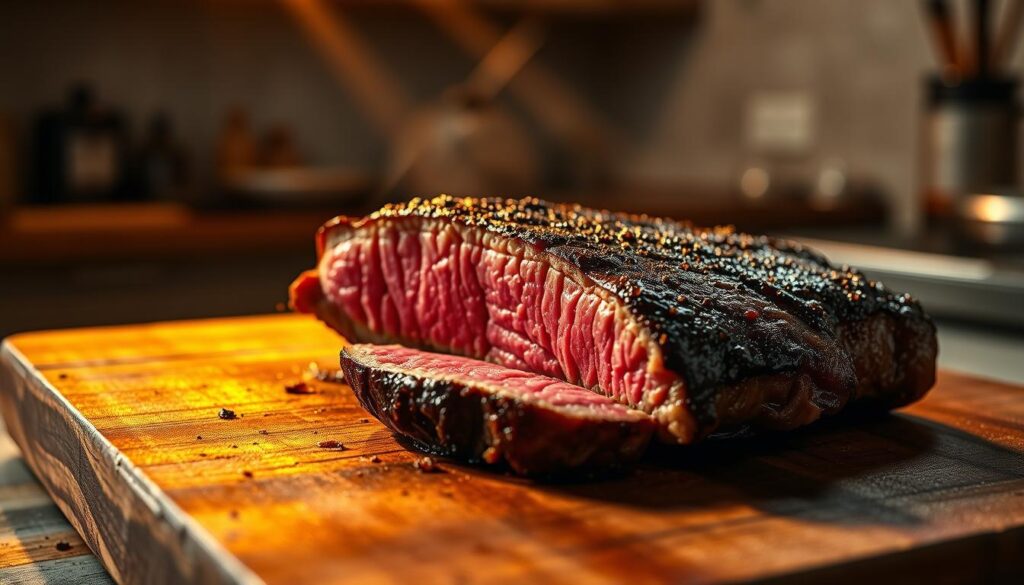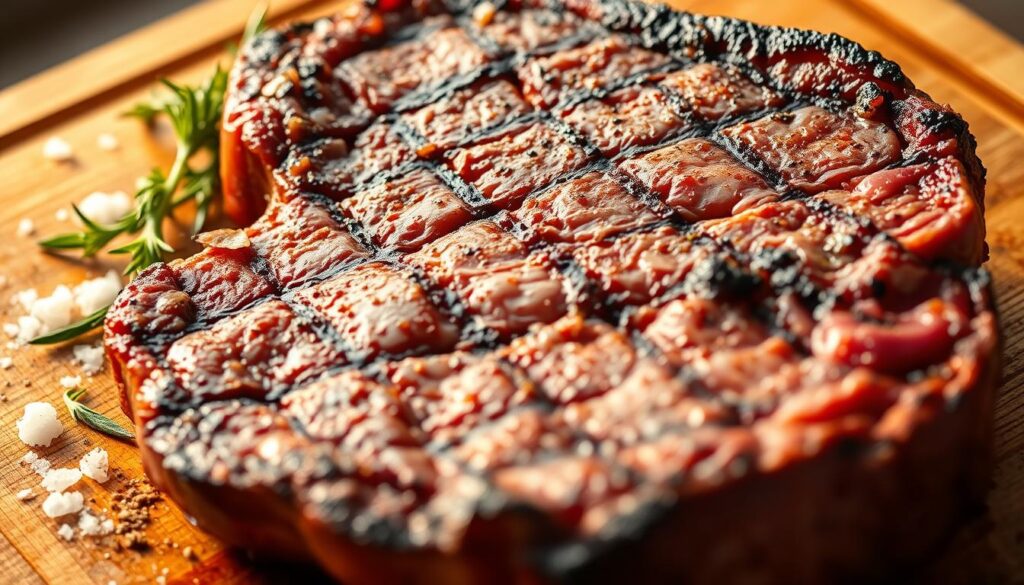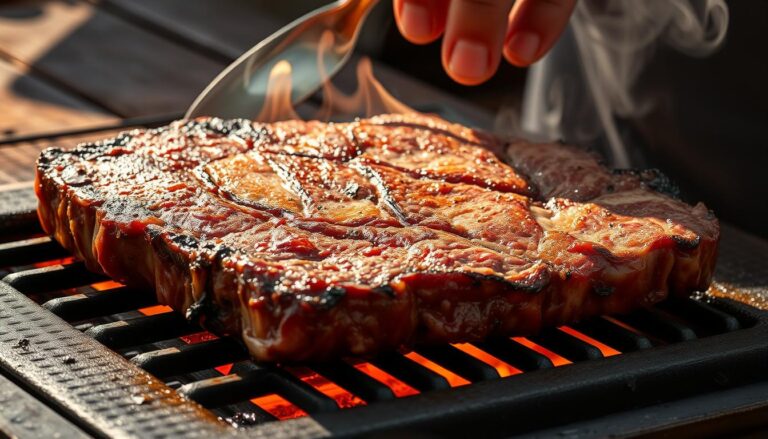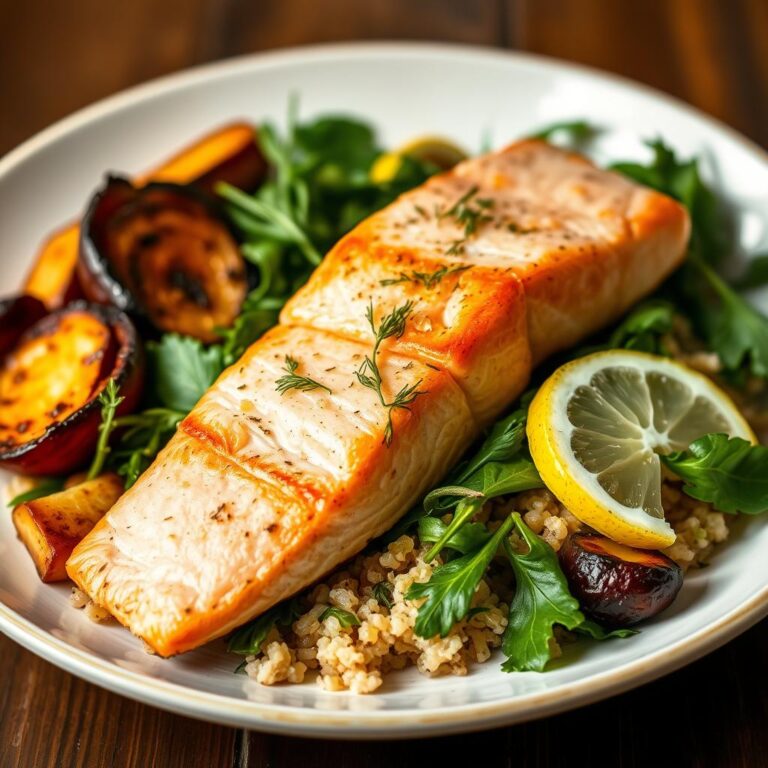How to Prepare the Most Flavorful Beef Steaks: Simple Recipes and Expert Tips
Every weekend, I would look at raw steaks and wonder how chefs made them so delicious. The secret to tasty beef steaks is not magic. It’s about knowing how to cook them right.
Getting a perfect steak at home might seem hard. But with simple recipes and expert tips, you can make amazing steaks in your kitchen.
Cooking a great steak isn’t about fancy ingredients or hard steps. It’s about knowing the basics that make a good steak amazing. Whether you cook often or just on weekends, these tips will make your steaks better.
Key Takeaways
- Master basic steak preparation techniques
- Learn professional cooking methods for consistent results
- Understand meat selection and quality
- Discover simple seasoning and cooking tricks
- Achieve restaurant-quality steaks at home
Understanding Different Cuts of Beef Steak
Choosing the right beef steak cut is key to a great meal. Not all cuts are the same. Knowing their differences helps you make tasty meals that fit your budget.
It’s important to know the difference between premium and value steaks. This choice affects flavor and tenderness. Each cut has its own texture, marbling, and cooking needs.
Premium Cuts: Ribeye, Strip, and Tenderloin
Premium steaks are top-notch in quality and taste. They’re pricier but offer a special dining experience:
- Ribeye: Rich marbling, intense flavor, perfect for grilling
- Strip Steak: Balanced tenderness and robust beef taste
- Tenderloin: Incredibly soft, lean, and mild-flavored
Value Cuts: Flat Iron, Flank, and Skirt
Value steaks are tasty and affordable. They need special cooking but are just as good:
- Flat Iron: Extremely tender, great for marinating
- Flank Steak: Lean, ideal for high-heat cooking
- Skirt Steak: Intense flavor, perfect for fajitas
Choosing the Right Cut for Your Recipe
Think about your cooking method and what you want to achieve. Consider:
- Cooking technique (grilling, pan-searing, broiling)
- Budget constraints
- Flavor preference
- Desired meat texture
Mastering beef steak cuts can elevate your cooking. With practice, you’ll pick the perfect steak every time.
Essential Equipment for Perfect Steak Cooking
To make restaurant-quality steaks at home, you need the right tools. Your kitchen’s equipment can turn a simple piece of meat into a masterpiece.
A cast iron skillet is key for great steak. It keeps heat well and cooks evenly, giving you a perfect sear. Both chefs and home cooks love it for its ability to make steaks golden brown.
- Cast iron skillet for optimal heat management
- Reliable meat thermometer for precise cooking
- High-quality tongs for safe meat handling
- Sharp chef’s knife for trimming and cutting
A meat thermometer is also vital. It gives you exact temperature readings, so you always get your steak just right.
| Equipment | Purpose | Recommended Type |
|---|---|---|
| Cast Iron Skillet | Even heat distribution | 12-inch pre-seasoned skillet |
| Meat Thermometer | Temperature accuracy | Digital instant-read probe |
| Tongs | Meat manipulation | Stainless steel with silicone tips |
Good steak cooking equipment doesn’t have to cost a lot. Most essential tools are affordable and can greatly enhance your cooking. Remember, making great steaks is about technique and the right tools, just as much as the meat itself.
The Importance of Meat Temperature and Preparation
Preparing steak is an art that starts long before cooking. Getting the steak temperature right can turn a simple meal into a masterpiece. Knowing how to bring meat to the right temperature and handle it ensures a tender and delicious steak.
Professional chefs know that making steak is more than just cooking meat. Paying close attention to details can greatly improve your cooking.
Bringing Steak to Room Temperature
Before cooking, take your steak out of the fridge and let it sit for 30-60 minutes. This step is key because it:
- Makes cooking more even
- Reduces cooking time
- Helps get a better sear
- Prevents tough, uneven meat
Proper Defrosting Steak Techniques
Defrosting steak safely is important. Don’t leave meat at room temperature for too long. Instead, use these safe methods:
- Refrigerator thawing (24-48 hours)
- Cold water method (1-2 hours)
- Microwave defrosting for quick cooking
Drying the Meat Surface
One important step is drying the meat surface. Pat your steak dry with paper towels before seasoning. This helps get a perfect golden-brown crust by removing excess moisture.
Mastering these preparation techniques will improve your steak cooking. You’ll impress everyone at dinner.
Quick and Easy Beef Steak Recipes for Busy Weeknights
Craving delicious steak but short on time? These quick steak recipes will make your weeknight dinners amazing. Easy steak dinners don’t have to be hard or take a lot of time.
Busy home cooks can make weeknight steak meals simple. The secret is to prepare ahead and use smart cooking methods. This way, you get great flavor without spending too much time in the kitchen.
- Pan-Seared Flat Iron Steak (5-Minute Marinade)
- Quick Ribeye with Herb Butter
- One-Pan Steak and Vegetable Dinner
A simple marinade can turn your steak into a top-notch dish. Pro tip: Mix olive oil, garlic, fresh herbs, and a bit of lemon juice for a flavor boost.
| Steak Cut | Prep Time | Cooking Time |
|---|---|---|
| Flat Iron | 5 minutes | 8-10 minutes |
| Ribeye | 3 minutes | 6-8 minutes |
| Flank Steak | 10 minutes | 8-10 minutes |
With these easy steak dinners, you’ll cook less and enjoy more. Your weeknight steak meals can be both quick and impressive.
Mastering the Art of Steak Seasoning
Turning a simple steak into a masterpiece starts with knowing about steak seasoning. Paying attention to salt timing and flavor can make a big difference. It can turn a basic steak into a dish that wows everyone.
Steak seasoning is more than just salt and pepper. It’s an art that needs precision and creativity. The right methods can bring out amazing flavors that make your steak unforgettable.
Salt Timing and Technique
The key to great steak seasoning is salt timing. Chefs suggest different methods:
- Salting right before cooking for a crunchy outside
- Salting 40 minutes before to help the meat absorb moisture
- Dry brining overnight for deep flavor
Herb and Spice Combinations
Boost your steak marinade with the right herbs and spices. They should enhance the meat’s natural taste:
| Herb Blend | Flavor Profile | Best Used With |
|---|---|---|
| Rosemary & Thyme | Earthy, robust | Ribeye, Strip Steak |
| Garlic & Black Pepper | Bold, spicy | Tenderloin, Flank Steak |
| Oregano & Paprika | Smoky, Mediterranean | Sirloin, Skirt Steak |
Creating Flavor-Enhanced Marinades
A good marinade mixes acid, oil, and spices well. Pro tip: Don’t marinate too long. Acid can make the meat tough.
- Start with olive oil, acid (like wine or citrus)
- Add garlic, shallots, and fresh herbs
- Use soy sauce or Worcestershire sauce for extra flavor
By learning these seasoning techniques, you can make your steaks amazing. You’ll impress everyone with your cooking skills.
The Reverse Sear Method: A Game-Changing Technique

The reverse sear method has changed how we cook steak at home. It brings precision and flavor that’s on par with restaurants. This technique makes sure your steak is cooked just right every time.
This method is different from the usual way of searing. You start by cooking the steak slowly at a low temperature. This makes the inside of the steak cook evenly. It also helps avoid overcooking and keeps the meat moist.
To use the reverse sear method, first season your steak with salt and pepper. Put the steak on a wire rack over a baking sheet. Cook it in an oven at about 275°F. Use a meat thermometer to check the temperature, removing the steak when it’s 10-15 degrees below your desired doneness.
The last step is to get a nice crust on the steak. Heat a cast-iron skillet until it’s very hot. Then, sear the steak for 45-60 seconds on each side. This step adds a golden-brown crust that locks in all the flavors.
While the reverse sear method takes a bit longer, the results are amazing. You’ll get steaks that taste like they’re from a restaurant, with just a little effort.
Perfect Cooking Temperatures for Every Doneness Level
To get the perfect steak, you need to know about meat temperature. Whether you cook at home or dream of being a chef, understanding steak temperature is key. It changes how you cook and enjoy food.
Getting the right steak doneness isn’t a guess. A good meat thermometer is your best tool. It helps you make steaks that are just right for you.
Temperature Ranges for Different Doneness Levels
Knowing steak temperature is important for the perfect steak. Here are the temperatures for different doneness levels:
- Rare: 125°F (52°C) – Cool red center
- Medium Rare: 135°F (57°C) – Warm red center
- Medium: 145°F (63°C) – Warm pink center
- Medium Well: 150°F (66°C) – Slight pink center
- Well Done: 160°F (71°C) – Little or no pink
Using Meat Thermometers Effectively
To get accurate readings, put your thermometer in the thickest part of the steak. Make sure it’s not in fat or bone. Take the steak out of the heat 5 degrees before your target temperature. It will keep cooking as it rests.
Pro tip: Always let your steak rest for 5-10 minutes after cooking. This makes it more tender and flavorful.
Essential Oils and Fats for Steak Cooking

Choosing the right cooking oils for steak can change your cooking game. The right fats are key for a perfect sear and flavor. Not all oils are good for high-heat cooking.
When picking steak cooking fats, think about these things:
- Smoke point
- Flavor profile
- Heat stability
Here are some top oils for steak:
- Avocado oil – Highest smoke point (520°F)
- Grapeseed oil – Neutral flavor, high heat tolerance
- Refined coconut oil – Clean taste, excellent searing capability
- Clarified butter (ghee) – Rich flavor, high smoke point
Professional chefs like oils that don’t mess with the steak’s taste. Oils like canola or vegetable oil are great for high heat. Adding a bit of butter at the end can make the crust golden and delicious.
The right oil can make your steak amazing. Try different oils to find what you like best.
Pro Tips for Achieving Restaurant-Quality Sear
Getting a perfect steak crust at home is simpler than you think. Professional chefs have learned the secrets of steak searing. They turn an ordinary steak into a dish fit for a restaurant. The trick is knowing your cooking methods and tools.
A great sear needs precision and the right tools. Cooking steak in a cast iron skillet is the best way to get a delicious crust. This crust seals in the flavor and makes the steak look golden-brown.
Cast Iron Skillet Mastery
Your cast iron skillet is the key to great results. Here are the essential techniques:
- Preheat your skillet until it’s extremely hot
- Use high smoke point oils like avocado or grapeseed
- Pat the steak completely dry before searing
- Don’t overcrowd the pan
Heat and Timing Strategies
Managing heat is key for a perfect sear. Here are some professional timing tips:
| Steak Thickness | Searing Time | Heat Level |
|---|---|---|
| ½ inch | 1-2 minutes per side | High |
| 1 inch | 3-4 minutes per side | Medium-High |
| 1½ inches | 4-5 minutes per side | Medium |
Professional chefs say patience and practice are the secrets to a perfect steak crust. With these tips, you can make your home-cooked steaks taste like they’re from a restaurant.
The Science of Resting Your Steak

Understanding the science behind resting steak is key to a great meal. When you cook a steak, the heat makes the meat’s fibers contract. This pushes the juices towards the center of the cut.
Resting the steak lets these juices spread evenly through the meat. This time is important because the inside of the steak keeps getting hotter. This ensures it cooks evenly and keeps more flavor.
Chefs suggest the following resting times for steaks:
- Thin steaks (1/2 inch): Rest for 3-5 minutes
- Medium steaks (1 inch): Rest for 5-7 minutes
- Thick steaks (1.5-2 inches): Rest for 8-10 minutes
Cutting your steak too soon can lose a lot of juices. Letting it rest allows the fibers to relax. This lets the juices spread back into the meat, making it tender and flavorful.
Professional chefs use a trick: they cover the steak with foil to keep it warm. This stops it from cooking more but keeps it juicy and tasty.
Steak resting time is not just a tip—it’s essential for top-notch steak at home. A little patience during this time makes a big difference in the steak’s texture and taste.
Serving and Presentation Techniques
Turning a simple steak into a fancy dish is all about the right cutting and presentation. The last steps in making your meal can make it go from good to great.
It’s key to cut your steak the right way for both taste and looks. The main rule is to always slice against the grain. This makes the steak tender and more fun to eat.
Precision Cutting Methods
- Use a sharp knife with a long, thin blade
- Let the steak rest for 5-10 minutes before cutting
- Identify the grain direction and cut perpendicular to it
- Slice at a 45-degree angle for optimal presentation
Steak Plating Strategies
Plating your steak is an art that makes it look good and easy to serve. Using warm plates keeps the steak hot and makes it look more inviting.
| Plating Technique | Visual Impact | Recommended For |
|---|---|---|
| Diagonal Slicing | High visual interest | Dinner parties |
| Stacked Presentation | Elegant layering | Fine dining |
| Simple Fan Arrangement | Clean, classic look | Weeknight meals |
You don’t need to be a pro to make your steak look amazing. With a few easy steps, you can make your steak look stunning and taste great.
Conclusion
Turning your kitchen into a steakhouse is possible. You’ve learned key tips for cooking perfect steaks. These include choosing the best cuts, controlling temperature, and seasoning.
Now, you can enjoy steak dinners on weeknights. You know the secrets of searing, resting, and cutting meat. This guide helps you make meals like a pro, without fancy tools or hard steps.
Steak cooking is a journey of practice and love. Every time you cook, you’ll get better and more confident. Whether it’s a quick dinner or a special occasion, you’ll impress everyone with your steaks.
Your kitchen is ready for steak mastery. Use these tips, try new cuts and flavors, and enjoy making amazing steaks at home.







